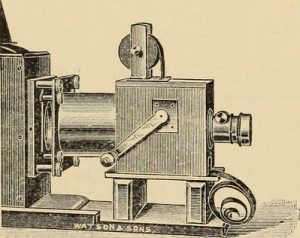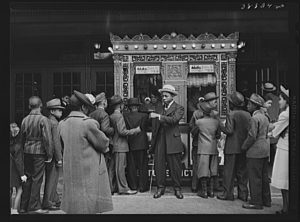Industrial Revolution (1800’s-1940’s)
49 The Kinetograph-The Impact of Cinematography
Nadia Slonaker

Introduction
The kinetograph, developed by Thomas Edison and William Kennedy Laurie Dickson, not only revolutionized visual storytelling by introducing the world to moving pictures, marking the inception of modern cinematography but also played a pivotal role in shaping early 20th-century society by creating a new form of entertainment and information dissemination. However, its impact was dual-faceted: while it democratized entertainment by making visual content more accessible to a broader audience, it simultaneously highlighted and exacerbated existing societal divisions, as access to this groundbreaking technology was primarily dictated by economic status and geographic location, thus perpetuating inequalities in the consumption and production of cultural and informational content.
Connection to STS
The advent of the kinetograph and the subsequent emergence of cinema had profound impacts on society, particularly in the realms of race, gender, and economic status. Initially, the accessibility of film as a medium was largely restricted by economic status, with the technology and the experience of cinema being exclusive to those who could afford it. However, as the technology evolved and became more widespread, it began to democratize storytelling, offering diverse social groups the chance to see their lives and stories reflected on screen. Yet, this expansion was not without its complications. Early cinema often mirrored the societal prejudices of its time, perpetuating stereotypes and reinforcing social hierarchies based on race and gender. Films produced during the early 20th century frequently portrayed women and racial minorities in roles that were either marginalized or caricatured, reflecting and reinforcing existing societal biases.

Despite these challenges, the growth of the film industry also provided unprecedented opportunities for minority and female filmmakers to carve out spaces for their voices within the new medium. Pioneering directors and actors of various racial and gender backgrounds began to use cinema as a platform to challenge prevailing stereotypes and advocate for social change, albeit within the constraints of their time. Over the decades, the film industry became a battleground for representation, with movies playing a critical role in shaping and challenging societal views on race, gender, and class. The democratization of film through advancements like the kinetograph eventually contributed to a more inclusive and complex portrayal of society, highlighting the power of visual media not just as a reflection of society but as a force capable of influencing and altering societal perceptions and attitudes. As cinema evolved, it became a vital tool for advocacy and representation, gradually transforming the landscape of societal norms and contributing to broader cultural and social shifts and it all started with the first camera, the kinetograph.
Background information
The kinetograph, often heralded as the precursor to modern film cameras, marked a pivotal moment in the history of filmmaking and visual storytelling. Invented in the late 19th century by Thomas Edison and his assistant, William Kennedy Laurie Dickson, this groundbreaking device was the first motion picture camera capable of capturing the fleeting moments of life on film. Unlike earlier photographic technologies that could only produce static images, the kinetograph utilized a rapid sequence of photographs to create the illusion of movement, thereby laying the foundational principles of cinema as we know it today. Its invention was not just a leap forward in technology but also a profound expansion of the creative horizons for artists and storytellers, enabling them to explore dynamic narratives and visual expressions in ways previously unimaginable.
The kinetograph’s operation hinged on a novel mechanism of moving film over a sprocket system, which allowed it to capture a series of images at a consistent speed. This mechanism was housed in a bulky, box-like structure, equipped with a peephole for viewing, and was often used in conjunction with the kinetoscope, a device designed for the individual viewing of these moving pictures. The early films shot with the kinetograph were simple scenes, lasting only a few seconds, but they were revolutionary, showcasing everyday events, such as the famous “Fred Ott’s Sneeze” or the movements of dancers and athletes. These initial experiments opened the door to the vast, untapped potential of motion pictures, setting the stage for the development of narrative cinema and the global film industry that would follow. Through its invention, the kinetograph not only transformed the entertainment landscape but also became a vital tool for education, documentation, and artistic expression, forever changing how we perceive and interact with the world around us.
Missing voices
The narrative of the kinetograph and its transformative impact on society, while celebrated for its technological innovation and cultural contributions, also brings to light the story of missing voices—those of countless inventors, filmmakers, and performers from marginalized communities whose contributions have been overlooked or underrepresented in the annals of film history. The early film industry, much like many other sectors during that era, was predominantly controlled by a subset of society that did not fully represent the diversity of human experience and creativity. This exclusion was not just a matter of recognition but also of opportunity; access to filmmaking technology and distribution channels was often gated by racial, gender, and economic barriers. Consequently, many potential narratives and perspectives were left unexplored or silenced, their potential impact on the medium and its audience untapped. The stories of women, people of color, and those from lower economic backgrounds who played roles in the early days of cinema—whether as creators, innovators, or subjects—are crucial yet frequently missing pieces of the puzzle. Recognizing and reclaiming these lost narratives is essential not only for honoring the true, multifaceted history of film but also for understanding the ways in which cinema has been shaped by a broader spectrum of human experience and insight than is often acknowledged.
Conclusion
In conclusion, the kinetograph, a seminal invention by Thomas Edison and William Kennedy Laurie Dickson, catalyzed the birth of modern cinematography and profoundly shaped early 20th-century society by transforming both the nature of entertainment and the dynamics of information dissemination. While it democratized the visual storytelling landscape, making moving pictures accessible to a broader public, it also underscored and amplified existing social divisions, as access to this innovative technology was predominantly influenced by economic and geographical factors. This dual impact not only facilitated a broader representation and exploration of diverse narratives in film but also perpetuated entrenched societal inequalities. Furthermore, the history of the kinetograph reminds us of the untold stories of marginalized inventors and creators in film, underscoring the importance of recognizing and integrating these overlooked voices to truly appreciate the multifaceted evolution of cinema. Thus, the kinetograph’s legacy is marked by both its revolutionary contributions to the arts and its complex role in the social stratification and cultural development of its time.
References
Andrew L. Yarrow. (1988, Oct 08). Centenary for edison, businessman and tinkerer: In a tiny tar-paper shack, the motion-picture industry was born. New York Times (1923-) Retrieved from http://libproxy.clemson.edu/login?url=https://www.proquest.com/historical-newspapers/centenary-edison-businessman-tinkerer/docview/110442613/se-2
Dickson, W. K. L., & Dickson, A. (2000). History of the kinetograph, kinetoscope and kinetophonograph. The Museum of Modern Art.
Howard Thompson’s special to THE NEW YORK TIMES. (1954, Feb 11). Ancient Machines Tell Movie Story: Edison’s Kinetograph Leads Historical Exhibits In Library Of Congress Earliest Origins Traced Display Includes ‘Fred Ott’s Sneeze,’ Pearl White and Pickford Film Plays. New York Times (1923-) Retrieved from http://libproxy.clemson.edu/login?url=https://www.proquest.com/historical-newspapers/ancient-machines-tell-movie-story/docview/113138816/se-2
Jaiswal, V., & Tiwari, A. (2013). A survey of image segmentation based on artificial intelligence and evolutionary approach. IOSR Journal of Computer Engineering (IOSR-JCE), 15(3), 71-78.
Keating, Patrick, editor. Cinematography. Rutgers University Press, 2014, https://doi.org/10.36019/9780813563510.
Lesso, Rossie. “Who Invented the First Motion Picture Camera?” TheCollector, 21 Sept. 2023, www.thecollector.com/who-invented-the-first-motion-picture-camera/.
Images
“Living pictures; their history, photoproduction and practical working. With a digest of British patents and annotated bibliography” by Hopwood, Henry V., 1866-1919 is in the Public Domain
“Entrance to movie theater. Southside of Chicago, Illinois” by Lee, Russell, 1903-1986, photographer is in the Public Domain
AI Acknowledgement
OpenAI. (2024). ChatGPT (April 2 version) [Large language model]. https://chat.openai.com/chat
I acknowledge the use of ChatGPT 4, March 21 version (https://chat.openai.com/) to generate the my chapter describing the history of the kinetograph. I entered the following prompt on March 20, 2024:
- Original Prompt: Write two paragraphs about the introduction of the kintograph, the first camera in film making.
- Follow-Up Prompt: Write two more paragraphs about how this new innovation affected society like race, gender, and economic status.
- Follow-Up Prompt: Write another paragraph about the missing voices revolving this camera.
The output from this prompt was refined and edited to cater to sources I also wanted to include.

